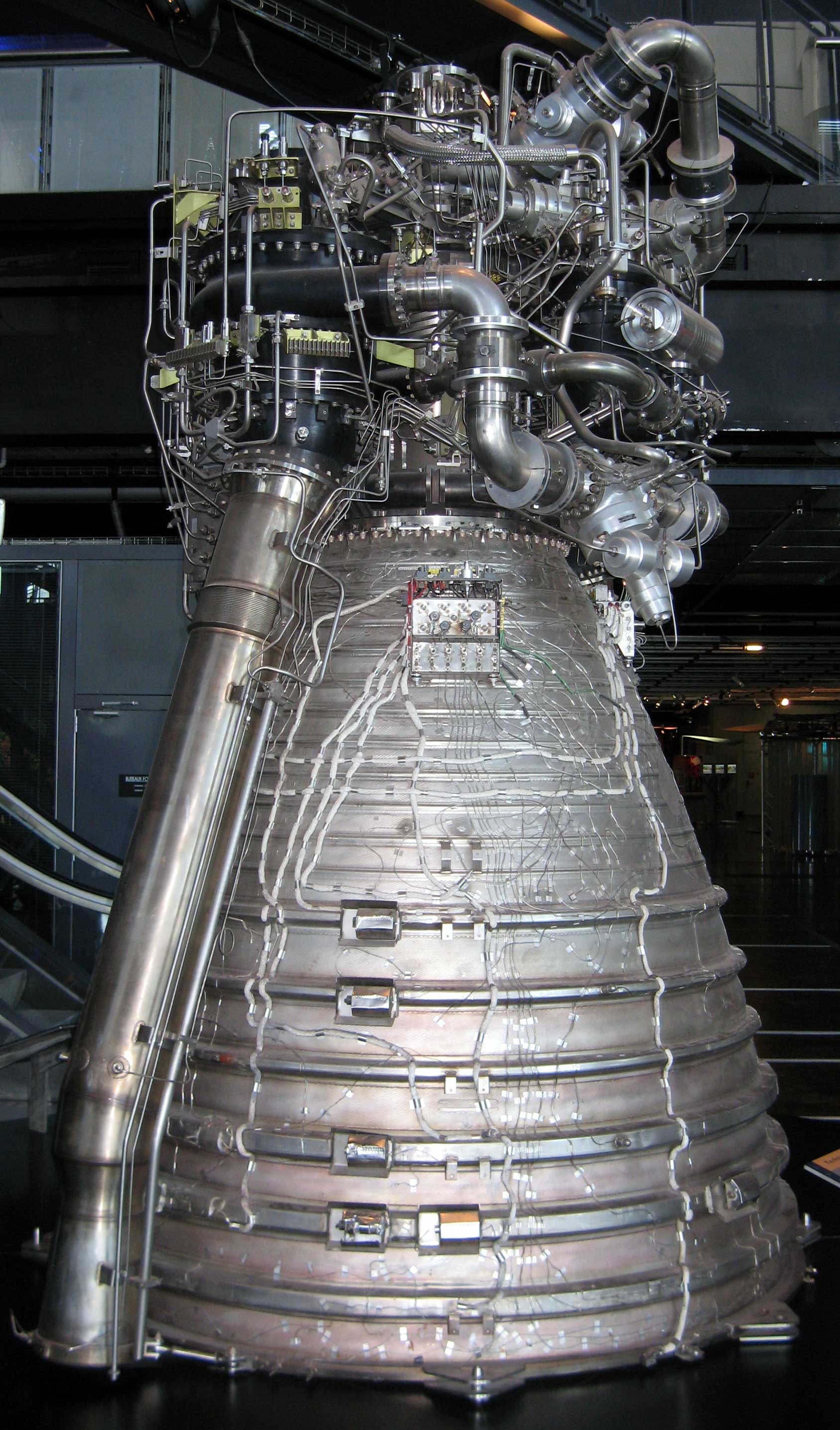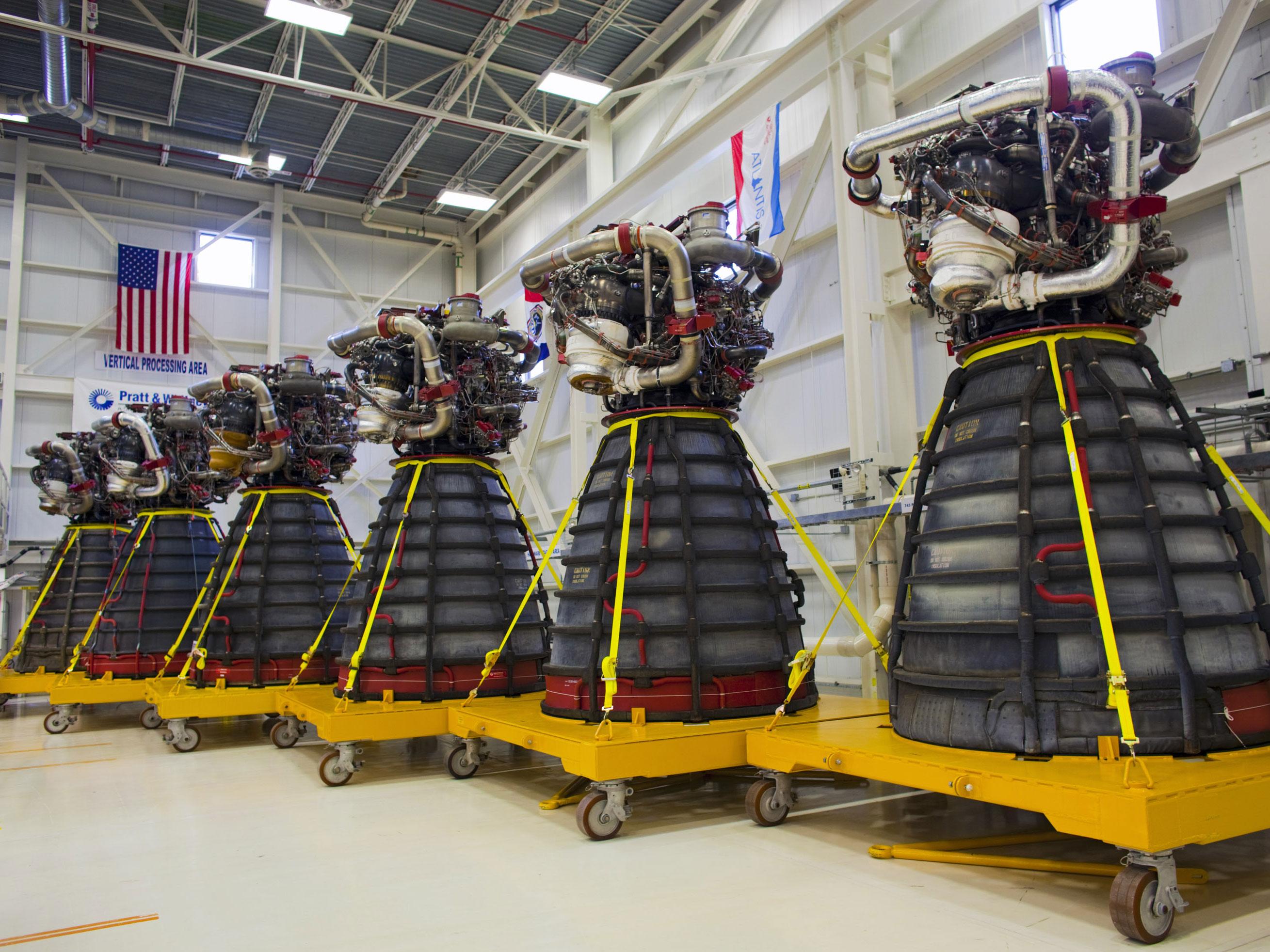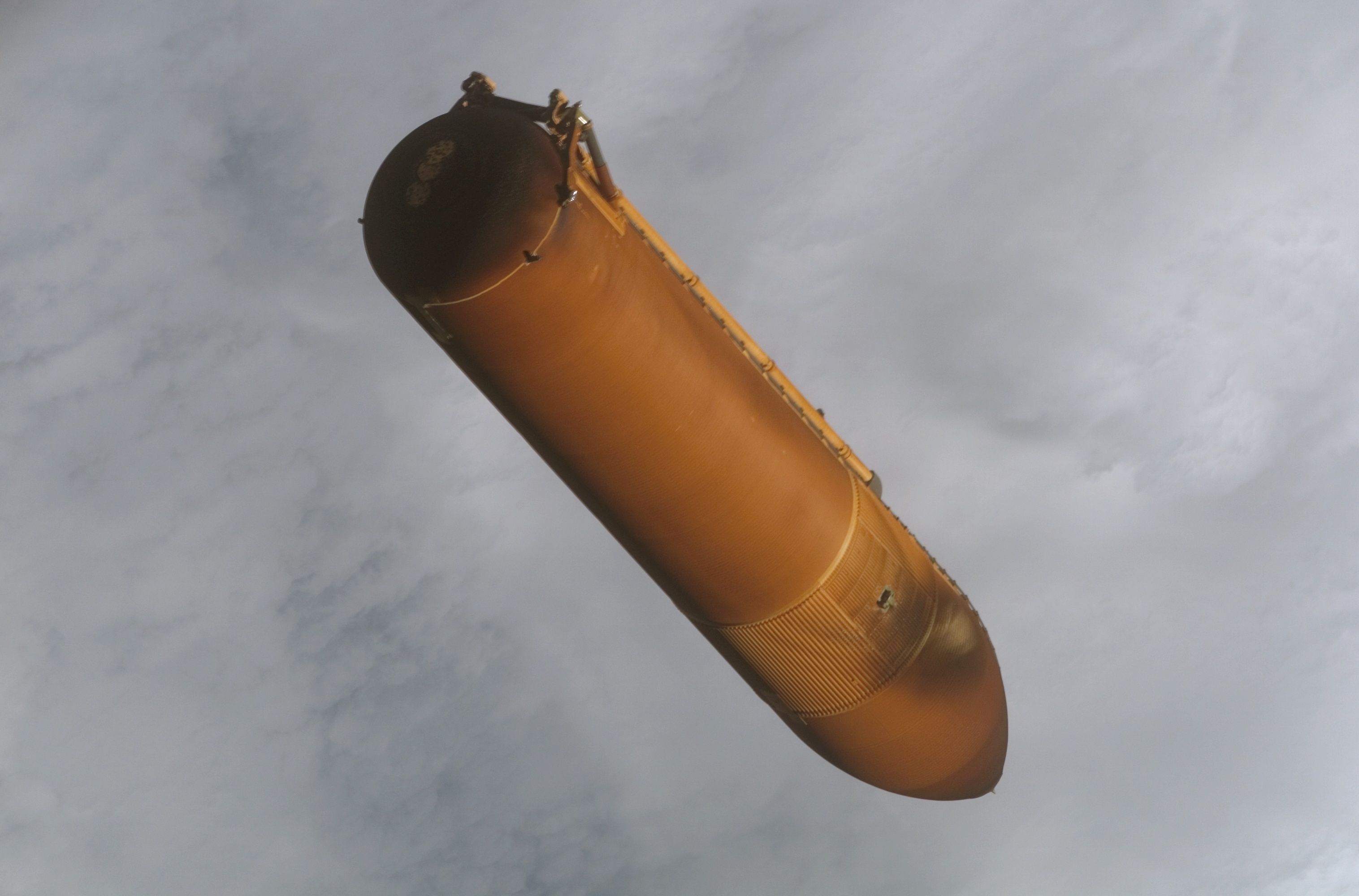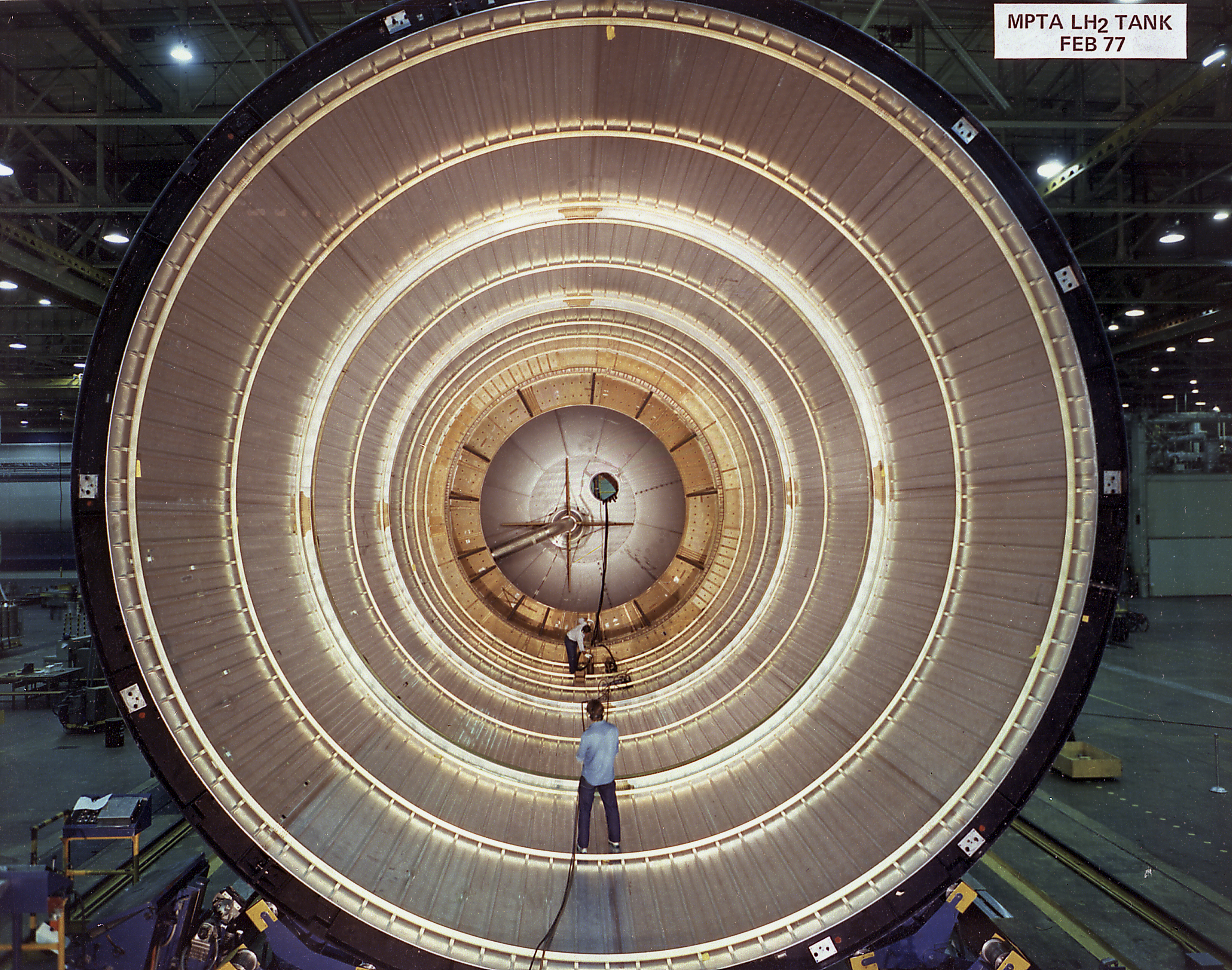|
SSME
The Aerojet Rocketdyne RS-25, also known as the Space Shuttle Main Engine (SSME), is a liquid-fuel cryogenic rocket engine that was used on NASA's Space Shuttle and is currently used on the Space Launch System (SLS). Designed and manufactured in the United States by Rocketdyne (later Pratt & Whitney Rocketdyne and Aerojet Rocketdyne), the RS-25 burns cryogenic liquid hydrogen and liquid oxygen propellants, with each engine producing thrust at liftoff. Although RS-25 heritage traces back to the 1960s, its concerted development began in the 1970s with the first flight, STS-1, on April 12, 1981. The RS-25 has undergone upgrades over its operational history to improve the engine's reliability, safety, and maintenance load. The engine produces a specific impulse (''I''sp) of in a vacuum, or at sea level, has a mass of approximately , and is capable of throttling between 67% and 109% of its rated power level in one-percent increments. Components of the RS-25 operate at tempera ... [...More Info...] [...Related Items...] OR: [Wikipedia] [Google] [Baidu] |
Space Shuttle Solid Rocket Booster
The Space Shuttle Solid Rocket Booster (SRB) was the first solid-propellant rocket to be used for primary propulsion on a vehicle used for human spaceflight. A pair of these provided 85% of the Space Shuttle's thrust at liftoff and for the first two minutes of ascent. After burnout, they were jettisoned and parachuted into the Atlantic Ocean where they were recovered, examined, refurbished, and reused. The Space Shuttle SRBs were the most powerful solid rocket motors to ever launch humans. The Space Launch System (SLS) SRBs, adapted from the shuttle, surpassed it as the most powerful solid rocket motors ever flown, after the launch of the Artemis-1 mission. Each Space Shuttle SRB provided a maximum thrust, roughly double the most powerful single-combustion chamber liquid-propellant rocket engine ever flown, the Rocketdyne F-1. With a combined mass of about , they comprised over half the mass of the Shuttle stack at liftoff. The motor segments of the SRBs were manufactured by ... [...More Info...] [...Related Items...] OR: [Wikipedia] [Google] [Baidu] |
NASA
The National Aeronautics and Space Administration (NASA ) is an independent agency of the US federal government responsible for the civil space program, aeronautics research, and space research. NASA was established in 1958, succeeding the National Advisory Committee for Aeronautics (NACA), to give the U.S. space development effort a distinctly civilian orientation, emphasizing peaceful applications in space science. NASA has since led most American space exploration, including Project Mercury, Project Gemini, the 1968-1972 Apollo Moon landing missions, the Skylab space station, and the Space Shuttle. NASA supports the International Space Station and oversees the development of the Orion spacecraft and the Space Launch System for the crewed lunar Artemis program, Commercial Crew spacecraft, and the planned Lunar Gateway space station. The agency is also responsible for the Launch Services Program, which provides oversight of launch operations and countdown management f ... [...More Info...] [...Related Items...] OR: [Wikipedia] [Google] [Baidu] |
Space Shuttle Orbiter
The Space Shuttle orbiter is the spaceplane component of the Space Shuttle, a partially reusable orbital spacecraft system that was part of the discontinued Space Shuttle program. Operated from 1977 to 2011 by NASA, the U.S. space agency, this vehicle could carry astronauts and payloads into low Earth orbit, perform in-space operations, then re-enter the atmosphere and land as a glider, returning its crew and any on-board payload to the Earth. Six orbiters were built for flight: ''Enterprise'', '' Columbia'', '' Challenger'', ''Discovery'', ''Atlantis'', and '' Endeavour''. All were built in Palmdale, California, by the Pittsburgh, Pennsylvania-based Rockwell International company. The first orbiter, ''Enterprise'', made its maiden flight in 1977. An unpowered glider, it was carried by a modified Boeing 747 airliner called the Shuttle Carrier Aircraft and released for a series of atmospheric test flights and landings. ''Enterprise'' was partially disassembled and retired aft ... [...More Info...] [...Related Items...] OR: [Wikipedia] [Google] [Baidu] |
Space Shuttle Orbiter
The Space Shuttle orbiter is the spaceplane component of the Space Shuttle, a partially reusable orbital spacecraft system that was part of the discontinued Space Shuttle program. Operated from 1977 to 2011 by NASA, the U.S. space agency, this vehicle could carry astronauts and payloads into low Earth orbit, perform in-space operations, then re-enter the atmosphere and land as a glider, returning its crew and any on-board payload to the Earth. Six orbiters were built for flight: ''Enterprise'', '' Columbia'', '' Challenger'', ''Discovery'', ''Atlantis'', and '' Endeavour''. All were built in Palmdale, California, by the Pittsburgh, Pennsylvania-based Rockwell International company. The first orbiter, ''Enterprise'', made its maiden flight in 1977. An unpowered glider, it was carried by a modified Boeing 747 airliner called the Shuttle Carrier Aircraft and released for a series of atmospheric test flights and landings. ''Enterprise'' was partially disassembled and retired aft ... [...More Info...] [...Related Items...] OR: [Wikipedia] [Google] [Baidu] |
Space Shuttle
The Space Shuttle is a retired, partially reusable low Earth orbital spacecraft system operated from 1981 to 2011 by the U.S. National Aeronautics and Space Administration (NASA) as part of the Space Shuttle program. Its official program name was Space Transportation System (STS), taken from a 1969 plan for a system of reusable spacecraft where it was the only item funded for development. The first ( STS-1) of four orbital test flights occurred in 1981, leading to operational flights (STS-5) beginning in 1982. Five complete Space Shuttle orbiter vehicles were built and flown on a total of 135 missions from 1981 to 2011. They launched from the Kennedy Space Center (KSC) in Florida. Operational missions launched numerous satellites, interplanetary probes, and the Hubble Space Telescope (HST), conducted science experiments in orbit, participated in the Shuttle-''Mir'' program with Russia, and participated in construction and servicing of the International Space Station (ISS). ... [...More Info...] [...Related Items...] OR: [Wikipedia] [Google] [Baidu] |
Specific Impulse
Specific impulse (usually abbreviated ) is a measure of how efficiently a reaction mass engine (a rocket using propellant or a jet engine using fuel) creates thrust. For engines whose reaction mass is only the fuel they carry, specific impulse is exactly proportional to the effective exhaust gas velocity. A propulsion system with a higher specific impulse uses the mass of the propellant more efficiently. In the case of a rocket, this means less propellant needed for a given delta-v, so that the vehicle attached to the engine can more efficiently gain altitude and velocity. In an atmospheric context, specific impulse can include the contribution to impulse provided by the mass of external air that is accelerated by the engine in some way, such as by an internal turbofan or heating by fuel combustion participation then thrust expansion or by external propeller. Jet engines breathe external air for both combustion and by-pass, and therefore have a much higher specific impulse than ... [...More Info...] [...Related Items...] OR: [Wikipedia] [Google] [Baidu] |
Rocketdyne
Rocketdyne was an American rocket engine design and production company headquartered in Canoga Park, California, Canoga Park, in the western San Fernando Valley of suburban Los Angeles, California, Los Angeles, in southern California. The Rocketdyne Division was founded by North American Aviation (NAA) in 1955, and was later part of Rockwell International (1967–1996) and Boeing (1996–2005). In 2005, the Rocketdyne Division was sold to United Technologies Corporation, becoming Pratt & Whitney Rocketdyne as part of Pratt & Whitney. In 2013, Pratt & Whitney Rocketdyne was sold to GenCorp, which merged it with Aerojet to form Aerojet Rocketdyne.Marjorie Censer(18 Dec 2022) L3Harris moves to acquire Aerojet Rocketdynefor $4.7 billion, after Lockheed Martin ended its attempt for Rocketdyne in Feb 2022 History After World War II, North American Aviation (NAA) was contracted by the Defense Department to study the German V-2, V-2 missile and adapt its engine to Society of Automotiv ... [...More Info...] [...Related Items...] OR: [Wikipedia] [Google] [Baidu] |
Cryogenic Rocket Engine
A cryogenic rocket engine is a rocket engine that uses a cryogenic fuel and oxidizer; that is, both its fuel and oxidizer are gases which have been liquefied and are stored at very low temperatures. These highly efficient engines were first flown on the US Atlas-Centaur and were one of the main factors of NASA's success in reaching the Moon by the Saturn V rocket. Rocket engines burning cryogenic propellants remain in use today on high performance upper stages and boosters. Upper stages are numerous. Boosters include ESA's Ariane 5, JAXA's H-II, and the United States Delta IV and Space Launch System. The United States, Russia, Japan, India, France and China China, officially the People's Republic of China (PRC), is a country in East Asia. It is the world's most populous country, with a population exceeding 1.4 billion, slightly ahead of India. China spans the equivalent of five time zones and ... are the only countries that have operational cryogenic rocket engines ... [...More Info...] [...Related Items...] OR: [Wikipedia] [Google] [Baidu] |
Aerojet Rocketdyne
Aerojet Rocketdyne is an American manufacturer of rocket, Hypersonic flight, hypersonic, and electric propulsive systems for space, defense, civil and commercial applications. Headquartered in Sacramento, California, the company is owned by Aerojet Rocketdyne Holdings. Aerojet Rocketdyne was formed in 2013 when Aerojet (then owned by GenCorp) and Pratt & Whitney Rocketdyne were merged, following the latter's acquisition by GenCorp from Pratt & Whitney. On April 27, 2015, the name of the holding company, GenCorp, was changed from ''GenCorp, Inc.'' to ''Aerojet Rocketdyne Holdings, Inc''. Lockheed Martin announced plans to take over Aerojet Rocketdyne on December 20, 2020 as part of a $4.4 billion acquisition; however this was abandoned by Lockheed on February 13, 2022 after opposition from Raytheon Technologies, Raytheon led the Federal Trade Commission, FTC to move to block the acquisition. Products Current engines * RS-25 (LH2/LOX) – Previously known as the Space Shuttle ma ... [...More Info...] [...Related Items...] OR: [Wikipedia] [Google] [Baidu] |
Space Shuttle External Tank
The Space Shuttle external tank (ET) was the component of the Space Shuttle launch vehicle that contained the liquid hydrogen fuel and liquid oxygen oxidizer. During lift-off and ascent it supplied the fuel and oxidizer under pressure to the three RS-25 main engines in the orbiter. The ET was jettisoned just over 10 seconds after main engine cut-off (MECO) and it re-entered the Earth's atmosphere. Unlike the Solid Rocket Boosters, external tanks were not re-used. They broke up before impact in the Indian Ocean (or Pacific Ocean in the case of direct-insertion launch trajectories), away from shipping lanes and were not recovered. Overview The ET was the largest element of the Space Shuttle, and when loaded, it was also the heaviest. It consisted of three major components: * the forward liquid oxygen (LOX) tank * an unpressurized intertank that contains most of the electrical components * the aft liquid hydrogen (LH2) tank; this was the largest part, but it was relatively ... [...More Info...] [...Related Items...] OR: [Wikipedia] [Google] [Baidu] |
Space Shuttle External Tank
The Space Shuttle external tank (ET) was the component of the Space Shuttle launch vehicle that contained the liquid hydrogen fuel and liquid oxygen oxidizer. During lift-off and ascent it supplied the fuel and oxidizer under pressure to the three RS-25 main engines in the orbiter. The ET was jettisoned just over 10 seconds after main engine cut-off (MECO) and it re-entered the Earth's atmosphere. Unlike the Solid Rocket Boosters, external tanks were not re-used. They broke up before impact in the Indian Ocean (or Pacific Ocean in the case of direct-insertion launch trajectories), away from shipping lanes and were not recovered. Overview The ET was the largest element of the Space Shuttle, and when loaded, it was also the heaviest. It consisted of three major components: * the forward liquid oxygen (LOX) tank * an unpressurized intertank that contains most of the electrical components * the aft liquid hydrogen (LH2) tank; this was the largest part, but it was relatively ... [...More Info...] [...Related Items...] OR: [Wikipedia] [Google] [Baidu] |
Liquid-fuel Rocket
A liquid-propellant rocket or liquid rocket utilizes a rocket engine that uses liquid rocket propellant, liquid propellants. Liquids are desirable because they have a reasonably high density and high Specific impulse, specific impulse (''I''sp). This allows the volume of the propellant tanks to be relatively low. It is also possible to use lightweight centrifugal turbopumps to pump the rocket propellant from the tanks into the combustion chamber, which means that the propellants can be kept under low pressure. This permits the use of low-mass propellant tanks that do not need to resist the high pressures needed to store significant amounts of gasses, resulting in a low mass ratio for the rocket. An inert gas stored in a tank at a high pressure is sometimes used instead of pumps in simpler small engines to force the propellants into the combustion chamber. These engines may have a higher mass ratio, but are usually more reliable, and are therefore used widely in satellites for orbit ... [...More Info...] [...Related Items...] OR: [Wikipedia] [Google] [Baidu] |








